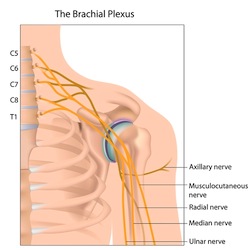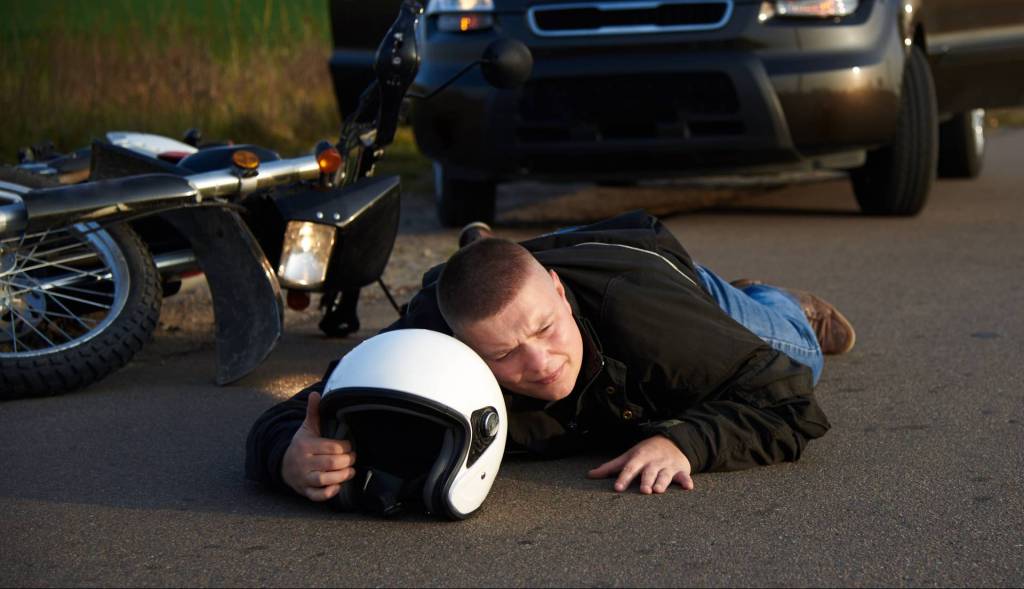What is Erb’s Palsy?
Erb’s palsy, sometimes called Brachial plexus palsy, is the medical term for a form of paralysis of the arm caused by a nerve injury to the upper arm and shoulder.
As you can see from the picture, the brachial plexus is a network of nerves that runs from the cervical spine in your neck, into your arm and hand. These nerves can be injured by stretching, tearing or other trauma or by inflammation of the nerves.
Although the brachial plexus can be injured by trauma from car accidents or sports, most Erb’s palsy injuries are caused by complications during child birth.
Erb’s Palsy from Birth Injuries: How does it happen?
Sometimes a baby’s shoulder can get “stuck” during deliver. This is a common complication and is referred to by doctors as shoulder dystocia.
If too much force is applied to the baby’s head or upper body when the doctor or nurse is trying to pull the baby out of the birth canal the brachial plexus nerves may stretch and be damaged.Types of Brachial Plexus InjuriesThere are actually three different types of brachial plexus injuries that can happen as a result of shoulder dystocia:
- Neuropraxia: This is the least serious form of brachial plexus injury. Scar tissue builds up around a nerve and interrupts the nerve signals. The problem can be corrected by surgery to remove the scar tissue which restores proper nerve function;
- Rupture: Occurs when the brachial plexus nerve is completely torn. When a nerve is ruptured, the most common repair requires surgeon to perform a nerve graft to bridge the gap caused by the rupture;
- Avulsion: This happens when the nerve root is pulled or severed from the spinal cord. This is the only brachial plexus injury that is properly referred to as Erb’s palsy. Although the nerve may recover on it’s own, the most common treatment for avulsion of the brachial plexus nerve is a nreve transplant. With appropriate treatment the child’s brain adapts to the new nerve pathway.
Effects of Erb’s Palsy from Birth Injuries
According to information from the Brachial Plexus Foundation, many brachial plexus injuries happen during birth. If your baby has been diagnosed with a brachial plexus injury, it is important to know the range of effects.
The effects of Erb’s palsy may decrease over time. Many children improve or even fully recover by three or four months of age.
On the other hand, some children can suffer long term residual difficulties. Infants may be able to move their wrist and hand but may not have full control of their shoulder and elbow.
If left untreated, Erb’s palsy can lead to severe disability of the shoulder, arm and hand. Approximately 20% of Erb’s palsy injuries result in permanent paralysis of the arm and shoulder.
Treatment for Erb’s Palsy
Sometimes the effects of a brachial plexus injury go away over time. If your baby suffers from an injury causing Erb’s palsy that requires medical treatment, there are a couple options available.
The first is physiotherapy. Up to 90% of brachial plexus injuries can heal better on their own than through surgery. Pediatric physiotherapy or occupational specialists can teach you special exercises to do with your baby to keep the arm functioning as much as possible – hopefully allowing it to heal by itself.
If the damage to the nerve is more serious, surgery may be required. Usually, the baby will undergo physiotherapy after surgery.
Statistically, if your baby has not fully recovered the use of their arm and shoulder by age two, it is unlikely they will ever develop full usage.“
Is my Baby at Risk?”
Your child is at a higher risk of suffering a brachial plexus injury that may cause Erb’s palsy:
- If you had previous delivery where your child had shoulder dystocia;
- If your labour has been induced or augmented (speeded up) with drugs like pitocen or syntocin;
- If you have diabetes;
- If you are having a larger baby (over 3.8 kilos at birth);
- If you have a small or unusually shaped pelvic opening (referred to as cephalopelvic disproportion);
- If you have prolonged labour;
- If your baby is in the breech (feet first) position;
- If there is malposition in the birth canal (your baby’s head is turned the wrong way during delivery).
Can Erb’s Palsy be Prevented?
Brachial plexus injuries are almost always avoidable with proper care during pregnacy, labour and delivery and proper risk management.
You can minimize the risk of injury by ensuring that you stay in good health during your pregnancy – including a proper diet for the benefit of you and your baby, and discussing the possible risks with your doctors to determine if you should consider an elective caesarean (C-section) delivery.
“What Can I Do?”
You can prepare for, and hopefully avoid, the possibility of your baby suffering a brachial plexus injury causing Erb’s palsy by discussing it with your obstetrician.
If you have any of the risk factors mentioned above your baby can be delivered a few days or weeks early before he/she becomes too large vaginal delivery.
If your baby suffers shoulder dystocia during delivery itself, there are several techniques that your doctor can use to resolve to dislodge your baby safely.
Doctors and nurses with current knowledge of these techniques are less likely to deliver an injured baby.
Conclusion
Sometimes complications can happen during labour and delivery that result in injury even if mom and baby receive proper medical care.
But Erb’s palsy is almost always a preventable injury. If you make sure your doctor is aware if you have any risk factors and if your doctors and nurses are capable and competent, there is almost no reason for your child to suffer an injury that may cause Erb’s palsy.
Think We Can Help You?
If your child has suffered a birth injury resulting in Erb’s palsy you can contact medical malpractice lawyer John McKiggan Q.C. online or by calling (877) 423-2050 or toll free at (877) 423-2050.
You can also get more free information on John’s Halifax Medical Malpractice Lawyer Blog.
You may also want to read John McKiggan’s book Health Scare: The Consumer’s Guide to Medical Malpractice Claims in Canada. You can buy a copy on Amazon.com (all sale proceeds are donated to charity) or you can get a free copy by contacting us through our website.












